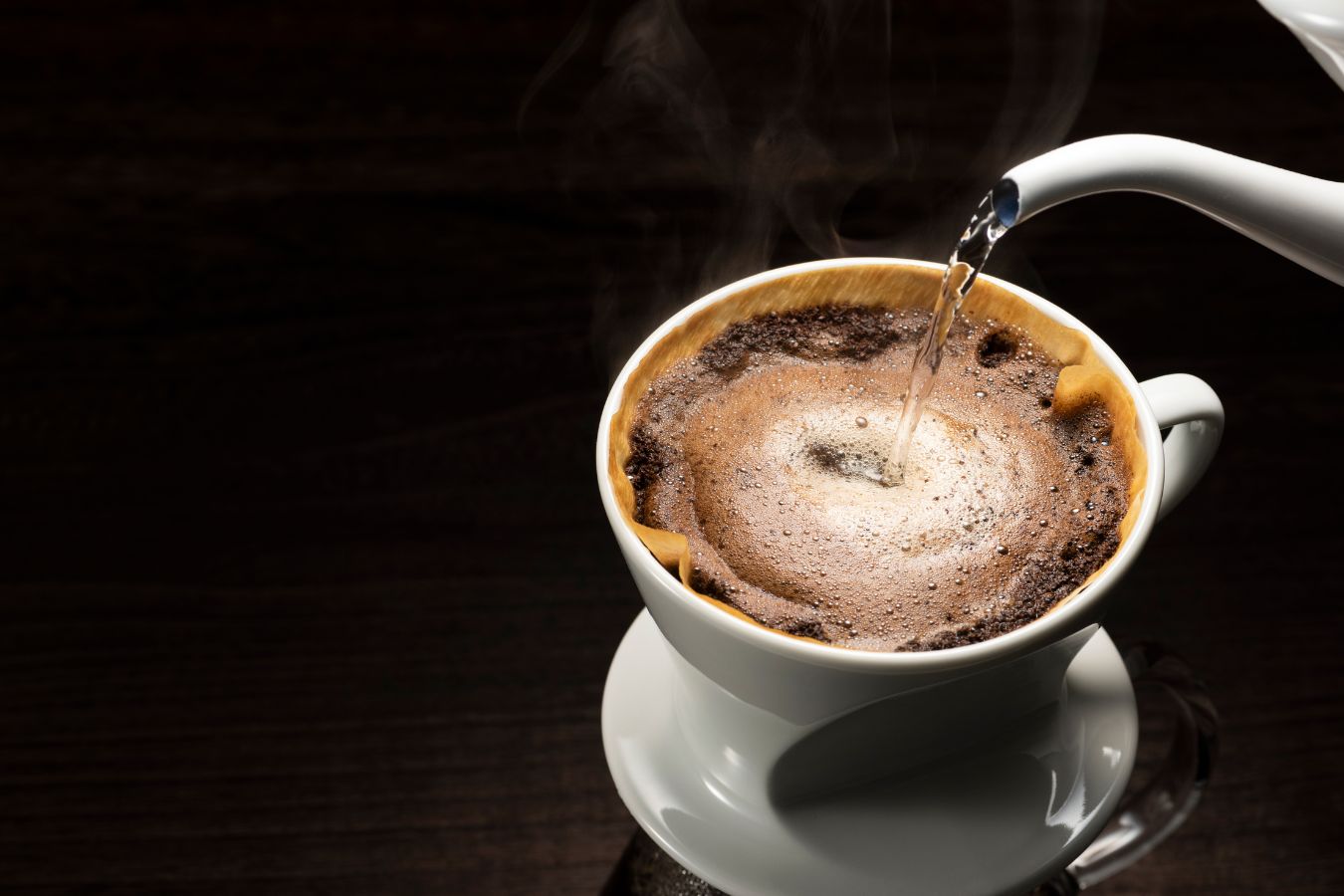
Basic Coffee Brewing Knowledge
11 Factors in making coffee
When brewing a cup of coffee, there are four essential elements to consider. The goal is to reflect the coffee’s natural flavor. The water + coffee will be the most crucial, followed by the grinder and the level of grinding, and finally, the preparation method. I’ll start with the most critical component.
Water
In this recipe, the solvent is water. The genuine essence of coffee flavor will be reflected by selecting the proper source of brewing water. Allows you to determine the quality of the coffee you are purchasing.
Because water chemistry is highly specialized, I will just cover a few points in this post.
*The water you use is colorless, turbid, and free of aromas like sulfur and phenol. If you mix regular tap water with it, there will be Cl, so keep the water for two days before using it. Cl’s aroma will overpower all of the coffee’s flavors. Because this is the most neutral range, it is advisable to use water pH 7-8,5. The goal is not to affect the coffee flavor too much. The neutralization of acids in water is measured in mg/l CaCO3, with CO32- and HCO3- referring to the two central bases.
If the excessive alkalinity makes the coffee taste bland, try it with Vinh Hao mineral water, which has lower alkalinity.
The coffee will have a sour and bitter flavor if low alkalinity. (I create my test water because I haven’t been able to get low-alkaline water to buy outside).
*
When brewing, the temperature should be between 80 and 98 degrees Celsius. The faster compounds are extracted, the higher the temperature, and vice versa. To make it mold, I usually mix it at 90 degrees. If it’s too bitter, I reduce the heat; if it’s too acrid, I increase the heat. The proportions of coffee and water must be identical. A cup of coffee with too much water will taste bland and bitter (thanks to the extended extraction of hot water to burn all the components), whereas a cup with too little water will taste quite strong.
After reading such a long post, the most crucial question is: Which coffee water should I buy?
Aquafina is the best water for artisan coffee because it best reflects the coffee’s flavor. Use Lavie or Ion Life if you prefer a balanced or light roast coffee that isn’t overly sour.
I only encountered three water filters with machine coffee (these filters are for coffee shops):
BWT Best Taste S, this is how I feel when I drink Espresso; it has a distinct flavor.
In this line, Pentair Everpure MC2, I believe Espresso will have an unmistakable scent (aroma).
I FIND THE FLAVOR REASONABLY BALANCED when I drink Cleansui (I lost the code for this line) and Espresso.
Note: The filters must be replaced regularly to ensure consistent coffee quality. We replace them based on the number of gallons of filtered water specified by the manufacturer. When installing the filter, you should include a water meter to make it easier to calculate when we need to replace it. We will change the filter fast or slowly depending on the amount of filtered water in each living area and the amount of filtered water.
I frequently use the ratio of 1g coffee:2g water as a mold for Espresso and 1g coffee:14g water as a mold for manual brewing. I’ll increase or decrease the ratio depending on whether it’s dark or light.
The coffee
You have to know how you like the solid or aromatic flavor. Choose the type of coffee that gives you the desired flavor. The items above I write are the basis for you to choose the kind of coffee when buying. Should buy coffee with clear information on the origin, preliminary processing, roasting level, and suitable preparation method.
Grinder
The blender is the key to extracting flavors. You have to know whether your need is for manual brewing or machine mixing, electric or manual grinding, conical burr, or flat burr. The larger the blade diameter, the better; the more expensive it is.
*Conical burr:
The blade is very durable; the edge price is often higher than the flat burr.
Take advantage of gravity to distribute coffee beans when grinding.
The rotation speed is low, so it is often used for manual grinders; if you use an electric grinder, you should start it up for a few seconds, then put the coffee in to evenly distribute the coffee powder.
Material: cast iron, ceramic, and steel.
Introduce some blender brands (in my opinion).
If you often brew manually, my advice is to use manual blender rice, only buy at two prices:
-From 300,000 to 1,400,000, you should refer to brands like Hario, Cafe de Kona, and Time more.
-Or above 5,000,000, you should refer to brands like Commanate, Kinu, and Helor.
I recommend using an electric grinder for machine-made coffee because manual grinding is very tiring and easy to burn the coffee. The models I have tried are Niche Zero and Mazzer Kony (of course, they will be expensive).
*Flar burr:
It is a famous line of grinding blades on the market, with many sizes; the price depends on the brand but will usually be cheaper than the conical burr blade.
The fast rotation speed to create a sizeable centrifugal force helps distribute the coffee evenly over the entire blade, making the coffee powder more even than the conical burr.
Faster wear time than conical burr blades due to more rapid revolutions.
They are usually used for electric blenders.
These blenders cost about 2,000,000 or more and are divided into two lines: machine and manual phase.
In the manual phase, people can refer to Hario, Akirakoki, and Kalita brands.
As for the machine, there are WPM suitable for families, Fiorengato eligible for traditional Italian coffee, and Mazzer, which I think is ideal for lightly roasted coffee.
With each different method, the grinder requires adjusting the coarseness and fineness, along with the uniformity in the coffee powder. There are two ways to change:
Step adjustment: pre-programmed coarseness levels for each blend by the manufacturer. Suitable for all types of brewing because you will quickly see the difference in coffee powder with the naked eye. However, it is difficult to adjust the fineness of each tiny size in Espresso.
Therefore, the second type was born, stepless adjustment: increasing the accuracy of fineness when adjusting more, suitable for machine coffee. However, we will spend more money on this adjustment, and it will take a lot of time and materials to determine the required level of fineness when making machine coffee.
The size of the powder when blended is determined by the mixing process and the bartender’s goal. The coarse powder will take longer to absorb water, making the extraction process slower, while the fine powder will down water, making the extraction process faster. Furthermore, the degree of roasting varies based on the hardness and softness of each type of coffee.
Espresso pha level of coffee powder
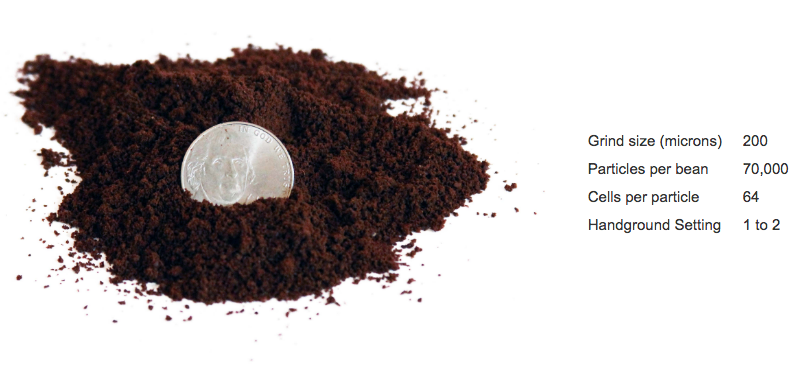
Coffee powder level for manual brewing methods
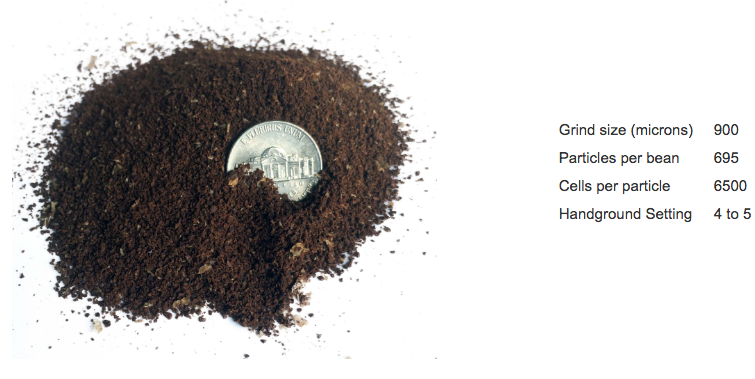

Preparation
This is merely a method, a tool for us to devise. However, it does not affect the essence of coffee flavor; each brewing method will best exploit each different aspect of the aroma, taste, or thickness (body).
Mixing can be done in two ways: by machine or by hand. The machine method is always superior to manual brewing when it comes to flavor.
We’ll go over each brewing method in detail, including the history, culture, and brewing procedure.
Gustav Kessel, a German, created the first sketchbook in 1878. Angelo Moriondo, on the other hand, took another six years to discover it. It was not until 1901 that it was made commercially available. It results from a collaboration between inventor Luigi Bezzera and marketer Desiderio Pavoni.
The coffee machine is then gradually improved over time.
When mixing, Luigi Bezzera uses a portafilter. Bezzera has been established.
Desiderio Pavoni adds a steam wand or a steam wand. La Pavoni is a well-known company.
Pier Teresio Arduino contributes to the public’s understanding of coffee. Victoria Arduino is a well-established businesswoman.
Giovanni Achille Gaggia breaks the 2 bar limit of prior steam-powered machines by introducing a lever-driven addition. Gaggia was established.
The Faema E61 was designed by Ernesto Valente, who replaced the Gaggia’s manual lever operation with a pump. Fama was established.
Giuseppe Bambi creates the Espresso GS, the first twin-boiler series featuring a steaming (whisking) boiler and an extraction boiler, which helps to keep the brewing temperature more consistent. La Marzocco is a well-known coffee company.
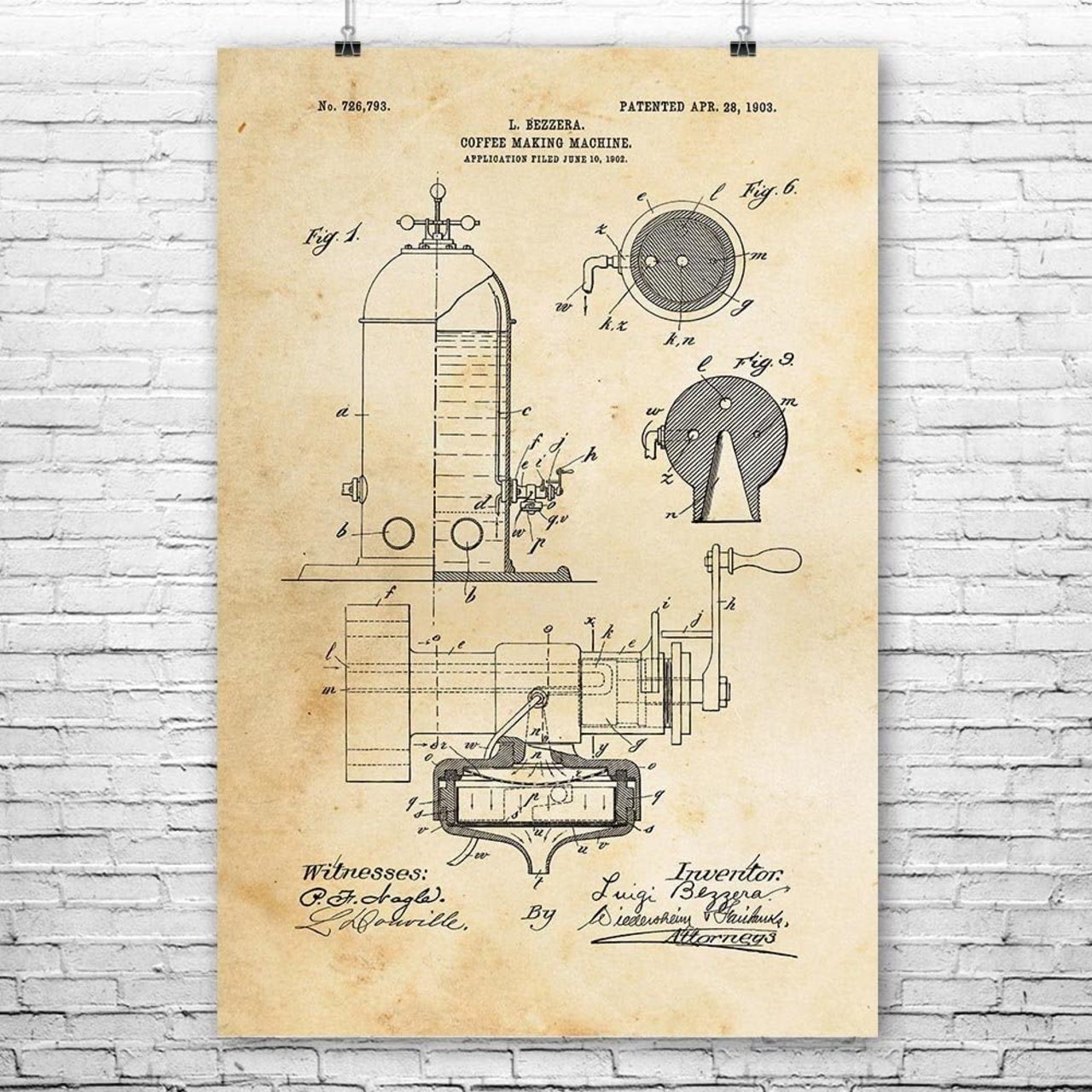
Other brands I’ve used include Astoria, Simonelli, Expobar of Spain, and others.
Espresso
As stated above, espresso is defined as a cup of coffee that is brewed and served fast.
Regular Espresso is provided in 25-30g shots, less than a standard 80-200g hand-brewed coffee.
The foundation of a fast espresso is high pressure throughout the brewing process. It also creates the crema layer and dissolves the oils in the coffee powder, giving the Espresso a fuller flavor than hand-brewed coffee.
Although insignificant, it guarantees that the user is sufficiently alert.
Espresso has progressed throughout time from being merely a sober beverage to addressing the needs of consumers seeking enjoyment.
Because a cup of Espresso is so small, the time to enjoy it is limited; everyone should smell it while it’s still hot and then start drinking while it’s still warm. It is not advisable to let it cool entirely before drinking it because the flavor has changed and is no longer the same.
In Italy, a standard cup of Espresso will have five distinct flavors that are split into five areas.
I drank famous Italian espresso producers such as Caffè Vergnano, Illy, Lavazza, and others.
When I started drinking coffee, like so many others, I was struck by how small and dense it was. However, after experimenting for a while, I discovered that the distinctive beauty of Espresso is that it is quick to brew and consume, taking only 2 to 3 sips while remaining flavorful.
Because the machine is out of stock, I spend my leisure time learning about coffee beans, buying beans, and then mixing them on the device to get an accurate comparison because there is no human mistake.
Some drinks based on Espresso
Espresso macchiato
The term “macchiato” is interchangeable with “marked,” as in “a point” or “marked.”
Bartenders first demonstrated the difference between a regular espresso and a milky espresso to wait for personnel.
Espresso and a dollop of milk foam are the only ingredients.
Suitable for a robust cup of Espresso. However, the coffee flavor will be pale when making a Cappuccino or Latte.
Latte/Cappuccino
After Espresso, these are the two most popular drinks, consisting of two ingredients: Espresso and hot whipped milk.
What if the components in these two drinks are the same? So, how do they differ from one another?
The most noticeable distinction is that the Cappuccino has a strong coffee flavor, while the Latte has a milky flavor. A classic Cappuccino has a capacity of 150-180ml, whereas a Latte has 200-220ml, resulting in the taste difference described above.
The Cappuccino milk foam layer will be thicker in foaming the milk than the Lattes.
One of the various roots of the term Cappuccino is the Minor Capuchin order’s brown robe (the line of Capuchin monks). In Vienna, Cappuccino is known as ‘Kapuziner,’ There is also “Vienna-style Cappuccino,” a cappuccino with whipping cream and cinnamon or chocolate crumbles on top.
Cappuccino gradually gained popularity throughout Europe after World War II, establishing a foundation for the entire world. Espresso machines, which have become widely available to the general public, are a part of the endeavor.
And while the word Latte translates to “fresh milk” in Italian, we now understand it to mean “coffee with fresh milk.” Its origins are “caffè e latte” (coffee and milk) in Italian, which is similar to “café au lait” in Northern Europe and France, and “café con Leche” in Spanish.
These two beverages have been reduced to Espresso with hot whipped cream as it is now, after many variations over the years.
A good cup of Cappuccino/Latte is defined by the presence of good Espresso, fresh milk at the proper temperature, and milk foam suitable for two types of drinks, as well as the even harmony of the crema layer, fresh milk, and milk foam; all served in a pre-warmed porcelain mug.
Nowadays, restrictions on Cappuccino/Latte will alter depending on the needs of different shops, such as the volume of cups used and the cups’ material, to suit each shop’s working style. The most noticeable difference between the two drinks, no matter how much it varies, is their taste.
The problem with fresh milk is when it’s hot; pasteurized fresh milk contains three key elements that you should look for when purchasing:
The result is protein when hydrophobic protein molecules are combined into long chains of amino acids in cold milk. When milk is heated, this is the component that produces foam.
The flavor of fats or fats is oily and fatty. When heated, milk tastes thin (thin body) and melts (melts) when consumed.
– Carbohydrates or sugars: double sugar radicals exist in cold milk; when heated, a pyrolysis process occurs, and a double sugar radical transforms into two single sugar radicals, making milk sweeter to drink. At 60-65 degrees Celsius, milk is the tastiest.

Some of you may be wondering why there are so many sources of recommendations for various milk heating temps than the ones I’m referring to when you read this line. So here’s how I’ll explain it to you in simple terms:
+ Level 50-55 degrees Celsius (this is a specific level for latte art because the molecules travel slower than the other two levels, resulting in a more stable milk foam layer when shaping (second law of thermodynamics).) milk foam is the primary material for shaping a latte/cappuccino. Recommendation: don’t drink just to lose weight; fresh milk is both fishy and fragrant at this time, and it’s easy to get stomach pain after drinking it, especially if you have a weak stomach like myself. Normally, I would instead not drink coffee than a pledge not to cuss when I go to a bar where the bartenders purposefully beat it so cold.
+ Levels above 65 degrees Celsius, like food cooked too carefully, the taste fades, as does fresh milk when it is too hot; this is the heating level often used in restaurants, suitable for those who sit and drink. + Levels below 65 degrees Celsius, like food cooked too carefully, the taste fades; this is the heating level often used in restaurants, suitable for those who sit and drink. Because the buyer’s time driving to another place reduces the heat of a latte/cappuccino, the maker will purposefully beat it hotter than usual because the milk is fresh. It will be fishy and taste terrible if you hit it hot and then let it cool completely.
Pasteurized fresh milk without sugar, such as Vinamlik, Dalatmilk, THtrueMilk, Lothamilk, Baristamilk, and others, is usually sold in restaurants depending on the purpose and desired price of the vendor.
We’ve got you covered if you’re having trouble deciding which milk brand to use to create latte/cappuccino at home.
Let’s look at the three cases below and smell and drink them all: To create a Latte/Cappuccino, first beat hot, then beat hot again. At the same time, compare many different varieties of milk. After experimenting, determine which milk brand best meets your needs and utilize that brand.
Because I’m unfamiliar with plant-based milk, I won’t endorse it.
Americano
The word “americano,” which means “America” in Italian or Spanish, is interchangeable with “Caffe americano.” According to several unsubstantiated sources, the name of this drink arose during World War II, when American soldiers fighting in Italy were unable to drink too strong Espresso. Hence, they diluted it with hot water to make it easier to swallow. Vietnam, a country known for consuming strong coffee but is compelled to drink such mild coffee, has a terrible reputation for coffee.
Espresso and hot water make the Americano; versions of this drink are commonly referred to as Americano; the distinction is in the taste.
-Americano: coffee first, hot water later. The tastes in the coffee are burned again when hot water is added later, resulting in more significant bitterness and astringency. Popular in the United States.
-Long Black: start with boiling water, then add coffee. The bitter (black) taste lingers, as the name implies (long). In Australia, it’s trendy.
Italiano also refers to a short Americano made with equal parts Espresso and hot water (e.g., 30g espresso equals 30g hot water). In the Far West, it’s trendy.
The hot water ratio for the two drinks, Americano and Long Black, varies by location; there is no standard formula. My balance is quite simple: I’ll use one espresso and 80% hot water from a cup/cup. For the iced Americano, simply fill the glass/cup halfway with ice, pour in 80% of the water, and add the Espresso.
Latte Mocha
Other names include Caffe Mocha and Mochaccino. The name stems from the Yemeni port of Mocha, which was one of the first coffee trading ports.
A cup of Latte is combined with chocolate sauce or cocoa powder that has been blended with sugar.
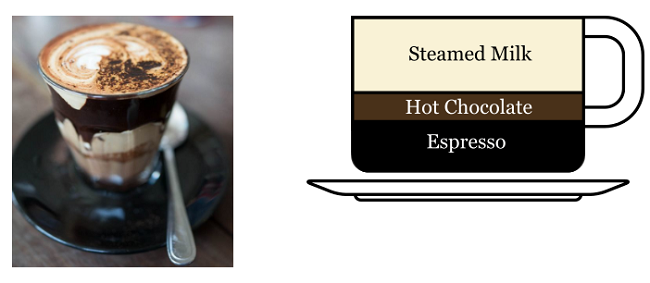
Everyone must be perplexed as to why the name Mocha appears here. Returning to the coffee taste map by continent, you’ll notice that Yemeni coffee beans are more chocolaty; historically, Mocha beans have been blended with coffee beans from the Indonesian island of Java to form Mocha Latte. Over time, Western cafe menus began to recognize the term “Mocha” as a cup of Latte with a chocolate taste, whereas the term “Java” and the phrase “a cup of joe” previously referred to a cup of black coffee.
Macchiato with caramel
If you don’t enjoy the mocha latte’s sweet and robust flavor, you can avoid this meal.
One cup of Latte plus caramel or vanilla sauce. On the surface of the glass, some caramel sugar was sprinkled.
This drink was introduced in the fall of 1996 to commemorate the company’s 25th anniversary.
Other foods made with Espresso include Irish coffee (traditionally paired with Jameson whiskey), Espresso Tonic, Cortado; etc.; I’ll save writing about them for another time.
Brewing coffee (brewing)
This is a long-established traditional way of brewing coffee. There will be distinct manual brewing instruments for each culture that enjoys coffee, and the filter material in the brewing tools will yield different coffee flavors as follows:
Because it maintains the vital oils (flavor oil) in coffee, the taste will be fatty (cream) and smooth (smooth), and it can be reused many times (about one year should be changed one year). The flaw is that it will put some excellent powder into the coffee cup, making it a little “fluffy” to drink. For use with an espresso machine, a Moka pot, or an Aeropress (purchase metal filter separately),…
Filter paper with a light to medium body and a distinct flavor. When mixing the two types of writing (white bleached and light yellow unbleached), properly rinse the piece with hot water to remove the pulp smell. Weaknesses cannot be reused as frequently as metal. Because the paper absorbs essential oils (flavor oils), you will notice the flavor more vividly in exchange for the lack of smoothness in the coffee cup. There are two sorts of paper: yellow (unbleached) and white (bleached) (bleached) V60, Kalita, Aeropress, and other funnels are commonly utilized.
-Cloth for the filter:
The flavor is reminiscent of a metal filter. The flaw is that if you don’t clean the fabric thoroughly when it’s finished, it will quickly smell like coffee, get rancid because the oil is still active, and seem filthy.
There are four types of strainer materials for some manual brewing methods:
Food-grade plastic is inexpensive, attractive, and long-lasting; you can carry it anywhere without fear of breaking it, and it retains heat for a long time. Cons: Many folks think it’s too inexpensive. This is the type I use the most because it’s so perfect, but anyone who says it’s cheap is lying.
-Porcelain: long-lasting advantage, ideal for stores since it is attractive and easy to clean and retains heat only to plastic. Cons: It is difficult to travel with because it is easily broken, and it is more expensive than a plastic funnel.
-Glass: it has the advantage of being beautiful, but it also has the problem of being fragile and retaining heat poorer than porcelain and more.
-Metal has the advantage of giving me a sense of solidity when I look at it. The disadvantage is that it is costly and holds heat poorly.
Drip method: This method, also known as a pour-over, is pouring a considerable volume of water into coffee powder through a funnel and filter. Hot water will pass through the coffee powder and then drip down, taking advantage of the earth’s gravity.
This approach is linked to the history of filter paper. Melitta Bentz, a German homemaker, noted that when brewing coffee by machine, the Moka Pot or French press tends to leave a fine powder in the coffee cup, and the cleaning process takes a long time. Cleaning cloth filters are too tricky.
She used a piece of paper from her son’s workbook in a steel funnel with a few holes punched after futile efforts. Then pour boiling water over the coffee on top of the filter paper. The coffee and water solution is poured into the cup directly. Compared to other brewing forms, the taste is less bitter and clear (clarity).
She created a company that sold funnels and filter paper, a successful invention.
If you go to a few craft coffee shops, you’ll see that folks are perplexed as to why there are so many various ways to pour. Alternatively, you can watch manual coffee brewing instructions on YouTube, where each person also instructs on how to run in each manner. The following is an easy-to-understand explanation:
Pouring can be divided into two types: intermittent pouring and continuous pouring. There aren’t many publications comparing the two approaches above, partially because this is a relatively new topic and partly because everyone enjoys coffee differently.
Suppose you wish to use a continuous pouring approach to create a drip effect. My recommendation is to get a gooseneck pourer (kettle gooseneck), which is essential in the preparation process because the key to the bottle is located in the cross-section of the faucet while pouring. The price range I recommend for the type without a base is between 450,000 and 1,000,000 dollars. The next item on the list is an accurate TFA thermometer, setting you back $500,000 extra.
Continuous pouring technique
This technique necessitates a significant amount of time spent honing your hand skills while continuously pouring water without interruption.
The continual pouring of water into the coffee powder with the desired amount of water is a technique. We’ll continue with the incubation procedure (blooming), which entails letting the coffee powder rise with enough water to wet the surface and then pouring continually with a steady stream of water.
The most important thing here is to keep the water flow under control while pouring.
The technique of intermittent pouring
This method is simple, gives more stability, and ensures that the water level never exceeds the filter’s maximum capacity.
The distribution of water on the ground coffee over time is referred to as a method. The total duration is usually less than 4 minutes and is determined by the number of times to pour and the time to wait each time.
If you wish to make a cup of coffee with a capacity of 200ml in 2 minutes, divide it into four equal portions of 50ml each and wait 30 seconds each time. Rep till you’ve reached 200ml.
V60
This is a phase hopper from the Hario firm in Japan. It has a V-shape with a 60-degree angle, spiral grooves inside the hopper to help circulate the flow, and a hole. a huge drainage system
The flaw is that if you brew for too long, the coffee will clog the drain at the top of the funnel, making it easy to burn the coffee.
Features: The brewing method allows for customization; pour rapidly for a light flavor and slowly for a robust flavor. As a result, each brewer will create a unique style, resulting in inconsistent quality.
I prefer a coffee from a particular region (single-origin coffee) with a pleasant aroma, like Ethiopia, but the taste is as pale as tea.
With three equilateral triangular drainage holes and a flat, circular funnel shape. This ensures a more consistent and equal coffee extraction than the V60.
Weaknesses: Because the hopper lacks air vents, the manufacturer makes filter paper with a wavy design on the filter paper wall, similar to the V60 (like a cake mold). It is difficult to transport and coat the filter paper because it is considered a loss of a sheet of paper if the paper wall is broken or when the water is covered, and the paper wall collapses.
When coating the Kalita Wave filter paper, pour water into the bottom of the form and wait for it to gradually spread to more than half of the article before pouring water out the edge.
Taste: more prosperous and more balanced than the V60.
For this blend, I usually use medium-roasted Ethiopian beans, Central-South American varietals like Costa Rica, or a mix of beans from other areas.
Using a Moka Pot as a brewing method
This is regarded as a method of preparing an “espresso at home,” albeit without using an espresso machine. In 1933, two Italians, Luigi De Ponti and Alfonso Bialetti came up with the idea. In today’s Italy, the Moka Pot is highly popular.
From the bottom up, the Moka jar is made up of three primary components: a water tank, a hopper, and a final product chamber. Aluminum or stainless steel with a plastic handle and an octagonal form is available. Aluminum is employed for gas or wood stoves, whereas stainless steel is excellent for gas, electric, and induction cookers. A Moka Pot from Bialetti costs between 750,000 and 1,200,000 dollars, depending on the capacity, material, and design color.
To be secure, my advice is to get authentic items, which cost around $300,000. I tried as also, but the aluminum is false and has a metallic odor when blended in large quantities.
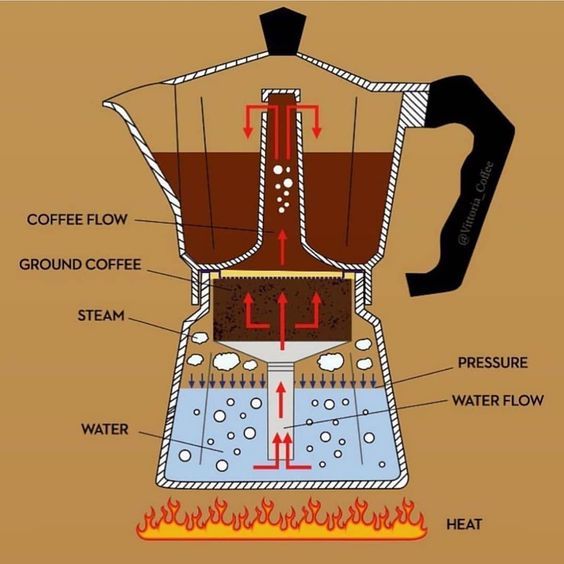
Working principle: When hot water boils, it creates high pressure, which forces hot water through a filter containing coffee powder, where the water and coffee mix and make completed products.
The amount of water poured should not be too little, as this will not create pressure, nor too much, as this will cause water leakage, and should only be run under the pressure relief valve.
People will undoubtedly ponder whether to fill the water tank with hot or cold water. It all depends on the bartender’s preferences.
Due to the decreased cooking time, which leads to faster extraction, the coffee will be fragrant, but the taste will be lighter than regular water.
For a more robust flavor, use plain water.
I propose a roast level ranging from medium to the whole roast. And the grind should be coarser than the drainage holes in the Moka Pot filter funnel’s metal filter mesh. For this style, I prefer to use Lavazza Classico coffee.
Because the Moka Pot pressure is low, the coffee powder should be evenly distributed in the hopper and not compressed. This will cause the extraction time to be very sluggish, resulting in a bitter and scorching taste.
Soaking method or French press
Only coffee powder, hot water, and a container such as a stainless steel cup or glass jar are required for this preparation method. Due to the numerous essential oils removed, coffee prepared using this approach will have a thick, rich flavor. However, due to the usage of a metal filter, some coffee powder residue will remain on the coffee cup.
In some households in the south of France, a French press is a favorite beverage, often served with warmed fresh milk. People have traditionally preferred coffees with a strong Asian flavor and a dark roast degree.
The French press comprises two primary parts: a pot for keeping coffee and water and another piece with a top and a metal filter. All you have to do now is pour boiling water over the coarse ground coffee powder, cover, and wait. The compression process takes around 5-10 minutes, and the goal is to remove the coffee powder from the final product.
Cold Drip/Cold Brew
The use of plain or cold water to prepare coffee distinguishes this approach.
The vital aspect is that it aids in preserving coffee for a more extended period, which is pleasant on hot days.
The flaw is that low-quality coffee is drinkable, but high-quality coffee is just drinkable. The flavor isn’t particularly distinctive.
The flavor of Cold Brew will be stronger than that of Cold Drip. If individuals want to add things like orange juice, soda, fresh milk, and so on, I propose Cold Brew; nevertheless, the coffee must be strong.
To separate the coffee grounds and the resulting solution, all you need is a jar, a scale, and a filter with Cold Brew.
When it comes to Cold Drip, you’ll need to invest in a drip system, which is costly. Cold Drip with some ice is recommended for aromatic coffees.
I propose mixing both Cold Brew and Cold Drip solutions if folks want a balance between the scent and flavor of the coffee they’re trying to create. I usually use Ethiopian and Colombian mixtures with 7g Cold Brew/3g Cold Drip.